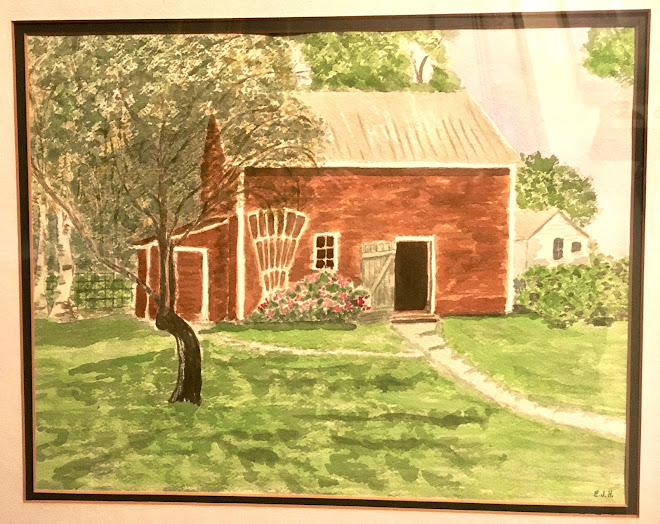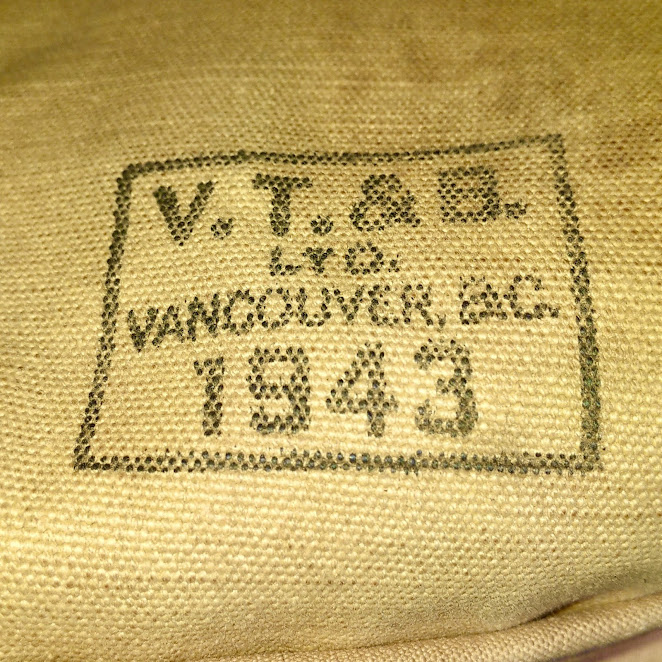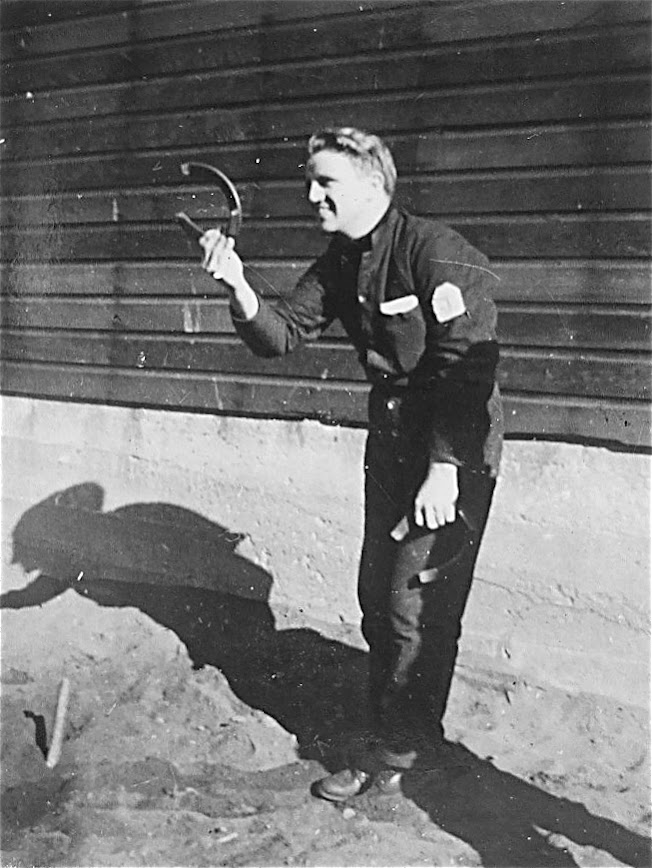A Navy Duffle Bag Hits the Road and Finds its Way Home
A Militaria Collector Follows a Rare Lead. Awesome!
Introduction:
My father Gordon Douglas ("Doug") Harrison was a member of RCNVR and Combined Operations during WWII and during the course of his service (June 1941 - September 1945) he was provided two navy duffle bags.
The first followed him from Hamilton ONT to many locations throughout the UK, e.g., during training exercises aboard landing crafts and to theatres of war during 1942 - 43 (including Scotland, London, Southern England, North Africa, Sicily and Italy) before being stolen - along w hundreds of others - from a warehouse in Egypt. (Details at bottom of page).
The second was likely given to him when he began round two of his service at a Combined Operations School or training base (HMCS Givenchy III) at Comox, Vancouver Island BC in January 1944.
By that time my father had become a bit more confident around women: He wrote about going out on dates while overseas and one relationship seemed pretty-darn-serious ("Where are you, Gracie Purvis?"); he had serious relationships with two women in his hometown of Norwich during December 1943. He married one in April 1944, was divorced within two years and married the other shortly thereafter; the second was the mother of his five children, including me.
About his lengthy leave in December 1943 Doug writes the following:
What can I say about fifty-two days leave at home? Draw it out... or say it was mostly wine, women and song? I guess that covers it without revealing too much.
"Dad, Well Done" Page 39
Though he doesn't reveal too much, the artwork on his navy duffle bag might indicate 'where his head was at' while on Vancouver Island. Though I do not know who the artist is, I can share a bit of the history associated with that colourful canvas tote.
For example, it travelled from Vancouver Island to my father's hometown of Norwich after he was discharged from duties with RCNVR and Combined Operations in September 1945. Though some of his navy gear likely found its way quickly into a bin, the navy bag survived until 1963 (approx.) in various dusty hiding places until I came across it - in the top level of the family barn behind my family's home.
After wondering "what the heck is this?" and brushing off year's of dust and inspecting it very closely ("Who the heck is this?") , I used it to carry my camping gear to a weekend-long Scout retreat after a colourful, heated argument - and brief - with my mother. It went something like this: "You're not taking that bag to the Scout camp." "Yes I am." "Take your gear out and use your hockey bag." "No. Good-bye." And away I marched with a couple of grinning mates.
I never saw the navy bag again after that weekend in the early 1960s, nearly 60 years ago. And several times over the last ten years, when I have been prompted for some reason to think of my Dad's navy career - e.g., while tramping around The Spit at HMCS Quadra near Comox BC, during three trips there - I shake my head at the loss of the duffle bag, believing that it likely ended up at the Norwich landfill site - "It's buried under tons of debris!" - and it's my own fault.
Knowing that another piece of canvas associated with my father's navy career survives World War II helps my mood at times, but the hammock did not personally belong to my father:
Recently, I received the following email:
Hello Gord,While doing some research on a navy duffle bag, which I have had in my militaria collection for many years, I have realized that it belonged to your Father (Gordon Douglas Harrison, RCNVR, V8809). Photos are attached. I would like to further discuss the possibility of returning this fantastic historical artifact to your family, if you are interested. I am originally from Hamilton, and now reside in Ottawa. I look forward to your reply!
Regards,
Walt Prawak
Sgt, (Retired) CD
RCCS
Thank you very much for reaching out to me with remarkable information.
I am indeed interested in seeing my father's navy duffle bag, even driving to Ottawa, and hearing how in the world you were able to come to have it, and then locate me based on just the details you have.
I last saw the hammock in 1964 approx., after finding it dust-covered in the upper reaches of my Dad's old barn. I later used it to carry my gear to a Scout camp for a weekend, against my mother's wishes, and I never saw it after that. I believed that it might have ended up in the dump in Norwich ONT, my parents' hometown. To see it in excellent condition is a real treat.
Coincidentally, I talked to my wife just yesterday morning about a trip to Ottawa so that I could connect once again with a person who works at the Navy Museum in downtown Ottawa, near the Jail Hostel (where I usually stay when visiting the capitol). I would also visit the War Museum as well, because I have two other Navy books to add to their collection, one being my father's navy memoirs. At both museums I want to pitch the idea of creating a display of artifacts, photographs and written information re the Canadian sailors (RCNVR) who had also volunteered for Combined Operations and manned landing crafts during WWII raids and invasions - my father being one. Not much has ever been shared about their efforts.
After two years overseas (having served at Dieppe and the invasions of N. Africa, Sicily and Italy), many returned home on leave before continuing their WWII service. Some were placed at HMCS Givenchy III (Combined Operations School or camp) on Vancouver Island, at "The Spit" from Jan. 1944 - discharge in later summer 1945, incl. Doug.
Photos are of the book cover of his memoirs; his foreword with name and volunteer number.
Again, thank you for connecting with me.
After a short argument I refused (which is bad, real bad) and he took me to have a chat with our huge, no-nonsense commanding officer Lt/Comdr Jacob Koyl, later to be known as Uncle Jake. L/S Bowen explained his case about my refusal to Mr. Koyl. With that, Bowen was dismissed and the commanding officer laid his big hand on my shoulder and started to recite, without benefit of the navy book, King Rules (KR) and Admiralty Instructions (AI) about the seriousness of refusing an order. I knew I was in for rough seas as he continued to expound, his big hand bowing my shoulder. Lt/Comdr Koyl wore navy boots so big they looked like the boxes they came in. I know, because I was looking at them; this officer didn’t walk, he plodded.
At the end of his recitation, this man, who later had the undying respect of every Canadian sailor under his command, said to me, “I am not going to punish you so it shows on your records. All I want my officers and men to do is work together so we can get the job done over here and we can all go home, and that includes baggage party.”
“Harrison!”
“You will be stowing kit bags and hammocks today, and every time a baggage party is required, you will be front and centre, and I’ll be standing by with my little eye on you.”
With that, he took his big hand off my shoulder, I straightened up, saluted, and said a little prayer. I was one lucky sailor; he could have come down much harder on me. The Canadian naval officer had played defense for the old New York Rovers farm team of the New York Rangers in the old six team NHL of 1939 - 40. I remember the dressing down he gave me and how his fingers sank into my shoulder to emphasize a point. A few years later, I remember talking to my sons in the exact same way.
Our particular group of Canadian sailors moved from ship to ship often and our numbers steadily grew until there were approximately 250, and when-ever we moved I was front and centre and, true to his word, Mr. Koyl was not too far away (smiling). Each time I was baggage party I learned a little more about KR and AI. I soon got to know over 200 kit bags personally and my muscles got larger like you wouldn’t believe. My knuckles were skinned on kit bag padlocks and my hands got burned on hammock lashings, and although I rose in rank under Mr. Koyl’s instruction, I remained baggage party. Badly bowed, but unbeaten, I had this job down to a science.
Mr. Koyl enjoyed every minute of it (I knew every wrinkle in his uniform), and once in awhile he heaped a few coals of fire on my head by thanking me for improving the time it took, and if there were medals struck for most improved sailor of the year and baggage party, he would be more than happy to recommend me. Yes sir! I never let on I heard his bantering; he had earned my respect as the hammocks flew and kit bags were piled high.
Late June, 1943 was the last time I helped move that huge mound of baggage. We were in Dejehli, Egypt and we stowed them in a wonderfully clean army building there. I put a navy padlock on the door (I’m kingpin now), the baggage party walked to a waiting truck and none of us ever saw our gear again. Our clothing, photos, souvenirs, everything we owned, went missing.
It took a lot of years, but the baggage episode did have a happy ending for me. In August, 1990 Leading Seaman Harrison visited Leading Seaman Bowen in Ottawa and L/S Bowen was detailed to carry my baggage from the car to the hotel room. Who was it that said, “It’s a long road that has no turning”?
Much decorated Lt/Comdr Jacob Koyl died in November, 1987 and was buried where he had earned his honours - at sea.
The story and many more can be found in "Dad, Well Done" my father's navy memoirs.
More Odds 'n Sods to follow as they come to mind, or are found, or rediscovered.
Please click here to view Odds 'n Sods: A Navy Knife and Spike
Photos GH and W. Prawak, Nepean ONT
















No comments:
Post a Comment